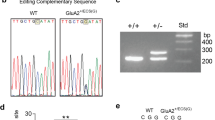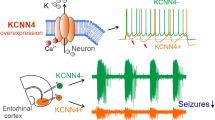Abstract
The Shaker-related potassium channel Kv1.1 subunit has important implications for controlling neuronal excitabilities. A particular recoding by A-to-I RNA editing at I400 of Kv1.1 mRNA is an underestimated mechanism for fine-tuning the properties of Kv1.1-containing channels. Knowledge about functional differences between edited (I400V) and non-edited Kv1.1 isoforms is insufficient, especially in neurons. To understand their different roles, the two Kv1.1 isoforms were overexpressed in the prefrontal cortex via local adeno-associated virus-mediated gene delivery. The I400V isoform showed a higher competitiveness in membrane translocalization, but failed to reduce current-evoked discharges and showed weaker impact on spiking-frequency adaptation in the transduced neurons. The non-edited Kv1.1 overexpression led to slight elevations in both fast- and non-inactivating current components of macroscopic potassium current. By contrast, the I400V overexpression did not impact the fast-inactivating current component. Further isolation of Kv1.1-specific current by its specific blocker dendrotoxin-κ showed that both isoforms did result in significant increases in current amplitude, whereas the I400V was less efficient in contributing the fast-inactivating current component. Voltage-dependent properties of the fast-inactivating current component did not alter for both isoforms. For recovery kinetics, the I400V showed a significant acceleration of recovery from fast inactivation. The gene delivery of the I400V rather than the wild type exhibited anxiolytic activities, which was assessed by an open field test. These results suggest that the Kv1.1 RNA editing isoforms have different properties and outcomes, reflecting the functional and phenotypic significance of the Kv1.1 RNA editing in neurons.






Similar content being viewed by others
Data Availability
The datasets generated during the current study are available from the corresponding author on reasonable request.
References
Jan LY, Jan YN (2012) Voltage-gated potassium channels and the diversity of electrical signalling. J Physiol 590(11):2591–2599. https://doi.org/10.1113/jphysiol.2011.224212
Begum R, Bakiri Y, Volynski KE, Kullmann DM (2016) Action potential broadening in a presynaptic channelopathy. Nat Commun 7:12102. https://doi.org/10.1038/ncomms12102
Jen JC, Baloh RW (2002) Genetics of episodic ataxia. Adv Neurol 89:459–461
Eunson LH, Rea R, Zuberi SM, Youroukos S, Panayiotopoulos CP, Liguori R, Avoni P, McWilliam RC et al (2000) Clinical, genetic, and expression studies of mutations in the potassium channel gene KCNA1 reveal new phenotypic variability. Ann Neurol 48(4):647–656
Paulhus K, Ammerman L, Glasscock E (2020) Clinical spectrum of KCNA1 mutations: new insights into episodic ataxia and epilepsy comorbidity. Int J Mol Sci 21(8):2802. https://doi.org/10.3390/ijms21082802
Rho JM, Szot P, Tempel BL, Schwartzkroin PA (1999) Developmental seizure susceptibility of kv1.1 potassium channel knockout mice. Dev Neurosci 21(3–5):320–327
Smart SL, Lopantsev V, Zhang CL, Robbins CA, Wang H, Chiu SY, Schwartzkroin PA, Messing A et al (1998) Deletion of the K(V)1.1 potassium channel causes epilepsy in mice. Neuron 20(4):809–819
Meiri N, Ghelardini C, Tesco G, Galeotti N, Dahl D, Tomsic D, Cavallaro S, Quattrone A et al (1997) Reversible antisense inhibition of Shaker-like Kv1.1 potassium channel expression impairs associative memory in mouse and rat. Proc Natl Acad Sci U S A 94(9):4430–4434
Ishida S, Sakamoto Y, Nishio T, Baulac S, Kuwamura M, Ohno Y, Takizawa A, Kaneko S et al (2012) Kcna1-mutant rats dominantly display myokymia, neuromyotonia and spontaneous epileptic seizures. Brain Res 1435:154–166. https://doi.org/10.1016/j.brainres.2011.11.023
Beraud E, Viola A, Regaya I, Confort-Gouny S, Siaud P, Ibarrola D, Le Fur Y, Barbaria J et al (2006) Block of neural Kv1.1 potassium channels for neuroinflammatory disease therapy. Ann Neurol 60(5):586–596. https://doi.org/10.1002/ana.21007
Wykes RC, Heeroma JH, Mantoan L, Zheng K, MacDonald DC, Deisseroth K, Hashemi KS, Walker MC et al (2012) Optogenetic and potassium channel gene therapy in a rodent model of focal neocortical epilepsy. Sci Transl Med 4(161):161ra152. https://doi.org/10.1126/scitranslmed.3004190
Snowball A, Chabrol E, Wykes RC, Shekh-Ahmad T, Cornford JH, Lieb A, Hughes MP, Massaro G et al (2019) Epilepsy gene therapy using an engineered potassium channel. J Neurosci 39(16):3159–3169. https://doi.org/10.1523/JNEUROSCI.1143-18.2019
Zhu P, Li J, Zhang L, Liang Z, Tang B, Liao WP, Yi YH, Su T (2018) Development-related aberrations in Kv1.1 alpha-subunit exert disruptive effects on bioelectrical activities of neurons in a mouse model of fragile X syndrome. Prog Neuro-Psychopharmacol Biol Psychiatry 84(Pt A):140–151. https://doi.org/10.1016/j.pnpbp.2018.02.011
Calvo M, Richards N, Schmid AB, Barroso A, Zhu L, Ivulic D, Zhu N, Anwandter P et al (2016) Altered potassium channel distribution and composition in myelinated axons suppresses hyperexcitability following injury. eLife 5:e12661. https://doi.org/10.7554/eLife.12661
Misonou H, Trimmer JS (2004) Determinants of voltage-gated potassium channel surface expression and localization in mammalian neurons. Crit Rev Biochem Mol Biol 39(3):125–145. https://doi.org/10.1080/10409230490475417
Kourrich S, Manrique C, Salin P, Mourre C (2005) Transient hippocampal down-regulation of Kv1.1 subunit mRNA during associative learning in rats. Learn Mem 12(5):511–519. https://doi.org/10.1101/lm.86305
Niespodziany I, Mullier B, Andre VM, Ghisdal P, Jnoff E, Moreno-Delgado D, Swinnen D, Sands Z et al (2019) Discovery of a small molecule modulator of the Kv1.1/Kvbeta1 channel complex that reduces neuronal excitability and in vitro epileptiform activity. CNS Neurosci Ther 25(4):442–451. https://doi.org/10.1111/cns.13060
Monaghan MM, Trimmer JS, Rhodes KJ (2001) Experimental localization of Kv1 family voltage-gated K+ channel alpha and beta subunits in rat hippocampal formation. J Neurosci 21(16):5973–5983
Bhalla T, Rosenthal JJ, Holmgren M, Reenan R (2004) Control of human potassium channel inactivation by editing of a small mRNA hairpin. Nat Struct Mol Biol 11(10):950–956. https://doi.org/10.1038/nsmb825
Hoopengardner B, Bhalla T, Staber C, Reenan R (2003) Nervous system targets of RNA editing identified by comparative genomics. Science 301(5634):832–836. https://doi.org/10.1126/science.1086763
Gonzalez C, Lopez-Rodriguez A, Srikumar D, Rosenthal JJ, Holmgren M (2011) Editing of human K(V)1.1 channel mRNAs disrupts binding of the N-terminus tip at the intracellular cavity. Nat Commun 2:436. https://doi.org/10.1038/ncomms1446
Balik A, Penn AC, Nemoda Z, Greger IH (2013) Activity-regulated RNA editing in select neuronal subfields in hippocampus. Nucleic Acids Res 41(2):1124–1134. https://doi.org/10.1093/nar/gks1045
Behm M, Ohman M (2016) RNA editing: a contributor to neuronal dynamics in the mammalian brain. Trends Gen : TIG 32(3):165–175. https://doi.org/10.1016/j.tig.2015.12.005
Decher N, Streit AK, Rapedius M, Netter MF, Marzian S, Ehling P, Schlichthorl G, Craan T et al (2010) RNA editing modulates the binding of drugs and highly unsaturated fatty acids to the open pore of Kv potassium channels. EMBO J 29(13):2101–2113. https://doi.org/10.1038/emboj.2010.88
Streit AK, Derst C, Wegner S, Heinemann U, Zahn RK, Decher N (2011) RNA editing of Kv1.1 channels may account for reduced ictogenic potential of 4-aminopyridine in chronic epileptic rats. Epilepsia 52(3):645–648. https://doi.org/10.1111/j.1528-1167.2011.02986.x
Krestel H, Raffel S, von Lehe M, Jagella C, Moskau-Hartmann S, Becker A, Elger CE, Seeburg PH et al (2013) Differences between RNA and DNA due to RNA editing in temporal lobe epilepsy. Neurobiol Dis 56:66–73. https://doi.org/10.1016/j.nbd.2013.04.006
Di Narzo AF, Kozlenkov A, Ge Y, Zhang B, Sanelli L, May Z, Li Y, Fouad K et al (2015) Decrease of mRNA editing after spinal cord injury is caused by down-regulation of ADAR2 that is triggered by inflammatory response. Sci Rep 5:12615. https://doi.org/10.1038/srep12615
Crabtree GW, Sun Z, Kvajo M, Broek JA, Fenelon K, McKellar H, Xiao L, Xu B et al (2017) Alteration of neuronal excitability and short-term synaptic plasticity in the prefrontal cortex of a mouse model of mental illness. J Neurosci 37(15):4158–4180. https://doi.org/10.1523/JNEUROSCI.4345-15.2017
Choi YJ, Choi YS (2016) Effects of electromagnetic radiation from smartphones on learning ability and hippocampal progenitor cell proliferation in mice. Osong Public Health Research Perspect 7(1):12–17. https://doi.org/10.1016/j.phrp.2015.12.009
Lorenzon NM, Foehring RC (1993) The ontogeny of repetitive firing and its modulation by norepinephrine in rat neocortical neurons. Brain Res Dev Brain Res 73(2):213–223. https://doi.org/10.1016/0165-3806(93)90141-v
Ghelardini C, Quattrone A, Galeotti N, Livi S, Banchelli G, Raimondi L, Pirisino R (2003) Antisense knockdown of the Shaker-like Kv1.1 gene abolishes the central stimulatory effects of amphetamines in mice and rats. Neuropsychopharmacology : official publication of the American College of Neuropsychopharmacology 28(6):1096–1105. https://doi.org/10.1038/sj.npp.1300162
Chi XX, Nicol GD (2007) Manipulation of the potassium channel Kv1.1 and its effect on neuronal excitability in rat sensory neurons. J Neurophysiol 98(5):2683–2692. https://doi.org/10.1152/jn.00437.2007
Baker MD, Chen YC, Shah SU, Okuse K (2011) In vitro and intrathecal siRNA mediated K(V)1.1 knock-down in primary sensory neurons. Mol Cell Neurosci 48(3):258–265. https://doi.org/10.1016/j.mcn.2011.08.007
Vacher H, Mohapatra DP, Trimmer JS (2008) Localization and targeting of voltage-dependent ion channels in mammalian central neurons. Physiol Rev 88(4):1407–1447. https://doi.org/10.1152/physrev.00002.2008
Willis M, Leitner I, Seppi K, Trieb M, Wietzorrek G, Marksteiner J, Knaus HG (2018) Shaker-related voltage-gated potassium channels Kv1 in human hippocampus. Brain Struct Funct 223(6):2663–2671. https://doi.org/10.1007/s00429-018-1653-x
Lai HC, Jan LY (2006) The distribution and targeting of neuronal voltage-gated ion channels. Nat Rev Neurosci 7(7):548–562. https://doi.org/10.1038/nrn1938
Sokolov MV, Shamotienko O, Dhochartaigh SN, Sack JT, Dolly JO (2007) Concatemers of brain Kv1 channel alpha subunits that give similar K+ currents yield pharmacologically distinguishable heteromers. Neuropharmacology 53(2):272–282. https://doi.org/10.1016/j.neuropharm.2007.05.008
Streit AK, Matschke LA, Dolga AM, Rinne S, Decher N (2014) RNA editing in the central cavity as a mechanism to regulate surface expression of the voltage-gated potassium channel Kv1.1. J Biol Chem 289(39):26762–26771. https://doi.org/10.1074/jbc.M113.545731
Coetzee WA, Amarillo Y, Chiu J, Chow A, Lau D, McCormack T, Moreno H, Nadal MS et al (1999) Molecular diversity of K+ channels. Ann N Y Acad Sci 868:233–285. https://doi.org/10.1111/j.1749-6632.1999.tb11293.x
Wang FC, Parcej DN, Dolly JO (1999) Alpha subunit compositions of Kv1.1-containing K+ channel subtypes fractionated from rat brain using dendrotoxins. Eur J Biochem 263(1):230–237
Ovsepian SV, LeBerre M, Steuber V, O'Leary VB, Leibold C, Oliver Dolly J (2016) Distinctive role of KV1.1 subunit in the biology and functions of low threshold K(+) channels with implications for neurological disease. Pharmacol Ther 159:93–101. https://doi.org/10.1016/j.pharmthera.2016.01.005
Rea R, Spauschus A, Eunson LH, Hanna MG, Kullmann DM (2002) Variable K(+) channel subunit dysfunction in inherited mutations of KCNA1. J Physiol 538(Pt 1):5–23
Ferrick-Kiddie EA, Rosenthal JJ, Ayers GD, Emeson RB (2017) Mutations underlying episodic ataxia type-1 antagonize Kv1.1 RNA editing. Sci Rep 7:41095. https://doi.org/10.1038/srep41095
Imbrici P, D'Adamo MC, Kullmann DM, Pessia M (2006) Episodic ataxia type 1 mutations in the KCNA1 gene impair the fast inactivation properties of the human potassium channels Kv1.4-1.1/Kvbeta1.1 and Kv1.4-1.1/Kvbeta1.2. Eur J Neurosci 24(11):3073–3083. https://doi.org/10.1111/j.1460-9568.2006.05186.x
Madison DV, Nicoll RA (1984) Control of the repetitive discharge of rat CA 1 pyramidal neurones in vitro. J Physiol 354:319–331. https://doi.org/10.1113/jphysiol.1984.sp015378
Gu N, Vervaeke K, Storm JF (2007) BK potassium channels facilitate high-frequency firing and cause early spike frequency adaptation in rat CA1 hippocampal pyramidal cells. J Physiol 580(Pt.3):859–882. https://doi.org/10.1113/jphysiol.2006.126367
Peron S, Gabbiani F (2009) Spike frequency adaptation mediates looming stimulus selectivity in a collision-detecting neuron. Nat Neurosci 12(3):318–326. https://doi.org/10.1038/nn.2259
Seamans JK, Yang CR (2004) The principal features and mechanisms of dopamine modulation in the prefrontal cortex. Prog Neurobiol 74(1):1–58. https://doi.org/10.1016/j.pneurobio.2004.05.006
Funding
This research was supported by the National Nature Science Foundation of China (grant number 81271197).
Author information
Authors and Affiliations
Contributions
Conception and research design: T. SU; collection of data: L. ZHANG, Z. PENG, W. BIAN, and P. ZHU; data analyses and interpretation: T. SU and B. TANG; preparation of figures: L. ZHANG and T. SU; manuscript writing: T. SU and W. LIAO
Corresponding author
Ethics declarations
Conflict of Interest
The authors declare that they have no conflict of interest.
Ethics Approval
All animal studies were conducted in accordance with the experimental practices and standards approved by the Institutional Animal Care and Use Committee of The Second Affiliated Hospital of Guangzhou Medical University (acceptance number: B2019-020).
Consent to Participate
Not applicable
Consent for Publication
Not applicable
Code Availability
Not applicable
Additional information
Publisher’s Note
Springer Nature remains neutral with regard to jurisdictional claims in published maps and institutional affiliations.
Supplementary Information
ESM 1
(DOCX 244 kb)
Rights and permissions
About this article
Cite this article
Zhang, L., Peng, Z., Bian, W. et al. Functional Differences Between Two Kv1.1 RNA Editing Isoforms: a Comparative Study on Neuronal Overexpression in Mouse Prefrontal Cortex. Mol Neurobiol 58, 2046–2060 (2021). https://doi.org/10.1007/s12035-020-02229-1
Received:
Accepted:
Published:
Issue Date:
DOI: https://doi.org/10.1007/s12035-020-02229-1




